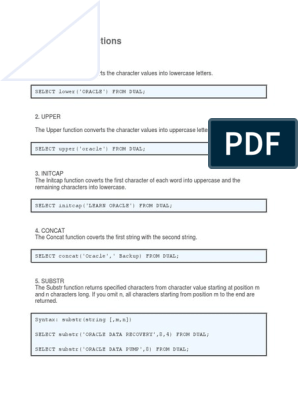Learn more about the LPAD and RPAD functions and see some examples in this article. Purpose of the Oracle LPAD and RPAD Functions. The Oracle LPAD function takes a text value, and “pads” it on the left, by adding extra characters to the left of the value to meet a specified length. It’s useful for ensuring that all values are the same.
To right-pad a text expression, use RPAD. Example: Oracle LPAD () function. In the following Oracle statement, the first argument specifies a string of characters, the second argument specifies that the length of the string returned after padding will be characters and the third argument specifies the string to be used for left padding.
So, characters (10-6) being used for left. Padding a string in Postgresql with rpad without truncating it. Ask Question Asked years, months ago. Active years, months ago.

Using substr to trim string on Oracle. Preventing sqlplus truncation of column. The table should not be empty at any point of time. If we try to pad a string with the same length as that of the string, then the Oracle LPAD Function returns the string.
Can we do using merge command to do the update and insert,we need to update,insert and delete. In SQL Server, you can use an expression using RIGTH, REPLICATE and LEFT functions to get the same result as Oracle. For example, the SQL LPAD Function query below tries to pad a string of length 10. If the character to be padded is longer than the requested total length, it will be trimmed to the exact total.

LPAD - Left-Pad String - Oracle to SQL Server Migration Note that the string is truncated if it already exceeds the specified length. When we are using FORALL construct to loop through bulk collect data, and if we run into un-handled exception, all the DML changes made during previous iterations will be rolled back but if we handle the exception correctly, it will Rollback the changes made during last execution which. This tutorial shows you how to use the Oracle LPAD () function to left-pad a string by specified characters to a certain length. Lpad : makes a string a certain length by adding (padding) a specified set of characters to the left of the original string 2. In Oracle , TRUNC(datetime, unit) function allows you to truncate a datetime value to the specified unit (set zero time, set the first day of the month i.e).
Your requirement to keep the number right justified suggests to use LPAD. Decimals separators can be a dot or a comma depending on nls settings. You can denote a decimal separator while converting a number to a character by using a 'D'. However, SQL Server (or more precisely, T-SQL), doesn’t include these functions.
So if you need some left padding, you’ll need to improvise. For these situations, Oracle Database offers LPAD and RPAD. When you call these functions, you specify the length to which you want your string padded and with what character or characters.
If you do not specify any pad characters, Oracle Database defaults to padding with spaces. RPAD means padding (spaces, by default) to the right.
Keine Kommentare:
Kommentar veröffentlichen
Hinweis: Nur ein Mitglied dieses Blogs kann Kommentare posten.